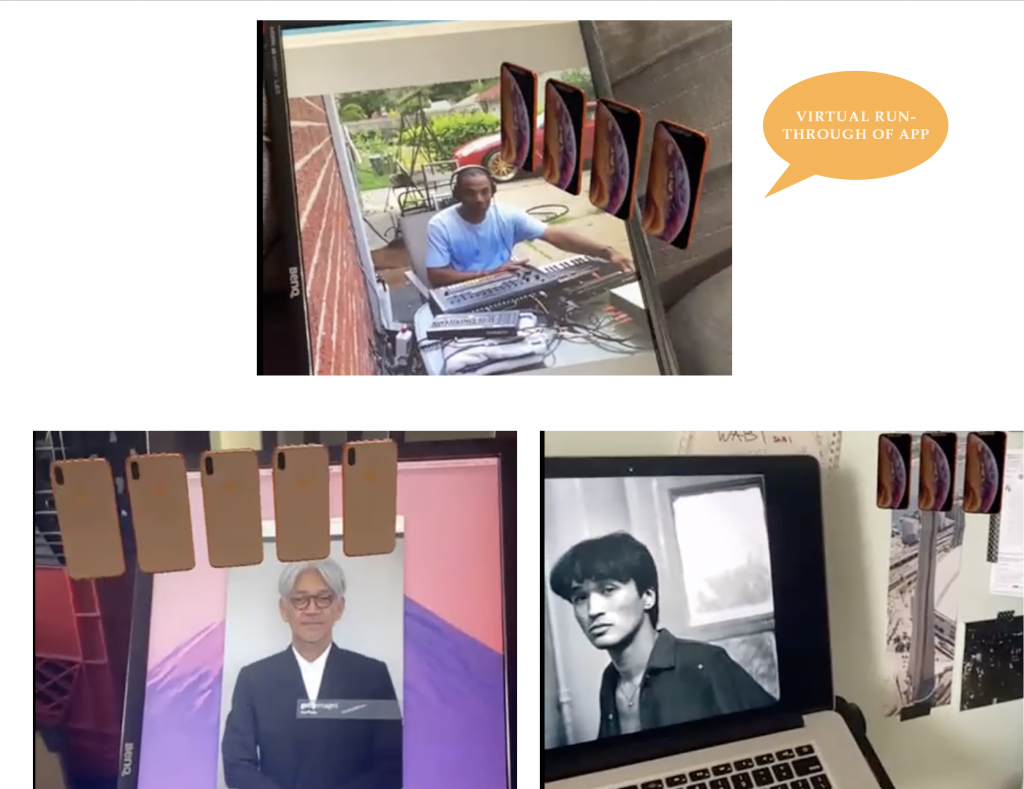
Silvio Chen, Yu Fujishiro, Vibhu Kamboj, Keeley Litzenberger, Vladislav Luchnikov, Rimsha Nawaz
‘Should I get a new phone’ is an experience in Augmented Reality designed to illuminate environmental issues associated with smartphone device disposal as well as visualize every individual’s contribution to the problem. The artwork is motivated by the lack of urgent attention to the irreversible environmental consequences our planet could and would inevitably face from the continued growth of e-waste production. The experience consists of a visual and an audio component and comes in a format of a smartphone app.
Conceptually, the visual component is simply a representation of an individual’s smartphone e-waste impact and is described by the number of smartphones that they would likely have owned by the date. This measure is based on an estimation of a person’s age and known rates of the global smartphone disposal. The audio part is conceptually more complex and serves as representative of individual level experiences and their resulting global outcomes. In particular, personal experiences leading to purchasing a new smartphone are described together with global environmental problems and worrying statistics.
Prior to the experience the users are advised that the device’s camera will be used and that in order to get full experience they will need to detect some people in the scene (detection is done via facial recognition). While in the experience, the app’s AR layer repeatedly performs spatial localization detecting faces around the device and providing an age estimation for each face. It then adds floating smartphone objects next to the person where the number of objects represents the number of smartphones that the person has owned by the date (real-world smartphone usage statistics are used to generate the number). The app’s screen also contains an ‘owned device’ counter that increases as the user detects more faces.
Simultaneously, they hear cycles of text2speech phrases where each phrase belongs to either one of the two groups – cause and effect as well as the connector phrase: ‘Should I get a new phone?’. First, a single cause for wanting a new smartphone is played (eg. ‘My phone freezes a lot..’) followed by the connector phrase and the effect phrase (eg. ‘1.5 billion smartphones are sold each year..’). Then, the cycle repeats, randomly picking a new pair of cause and effect from the phrase-bank. The connector phrase never changes.
Ultimately, the experience is designed so that by listening the users empathize with the conflict that arises when we compare and contrast an individual’s emotional motivation to purchase a new device with the global outcomes that multiples of those decisions generate. The visual layer here bridges the problem context that can be perceived as rather distant with the reality that lies immediately around the user generating a sense of presence.
From the 2020-2021 course:
DATT 3700 Collaborative Project Development
More than ever, society is looking to the social sciences and humanities to help understand and mitigate global challenges in the face of change. The Social Sciences and Humanities Research Council of Canada (SSHRC) created an initiative entitled Imagining Canada’s Future, which challenges Canada’s social scientists and humanities researchers to address emerging economic, societal and knowledge needs in order to help guide decision-making across all sectors towards a better future. In response to one of two selected probes, students will create artworks that will raise awareness to their selected theme.
The themes for this course will be:
1) Environment: Living Within Earth’s Carrying Capacity
Humankind is putting an unsustainable strain on the Earth’s capacity to support life. We are at, or near, the tipping point for several ecosystem services. Fundamental changes in our economic and political systems and our way of life may be needed over the next two or three generations if humans are to live within the carrying capacity of the planet.
2) The Pervasive Contamination of the ‘Natural’
Everything is contaminated. What is safe? Trash is obvious, but microplastic contamination of marine fish stocks is not, nor is the chemical contamination of groundwater resulting from our modern reliance on pharmaceuticals. We will be challenged to thrive in a world where contamination is pervasive at all scales and in all environments.
Students were challenged to reflect on and consider the bigger problems contributing to the above issues by following a problem analysis methodology, and then create an artwork that addresses the identified problem. The created artworks may incite awareness in their viewer, speculate about possible futures (dystopic/utopic), or provide solutions.
Return to the Digital Media END OF YEAR EXHIBITION 2020 • 2021